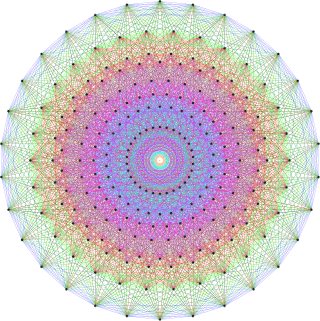Representation of a Lie group
| Group theory → Lie groups Lie groups |
|---|
 |
|
In mathematics and theoretical physics, the idea of a representation of a Lie group plays an important role in the study of continuous symmetry. A great deal is known about such representations, a basic tool in their study being the use of the corresponding 'infinitesimal' representations of Lie algebras. The physics literature sometimes passes over the distinction between Lie groups and Lie algebras.
Representations on a complex finite-dimensional vector space
Let us first discuss representations acting on finite-dimensional complex vector spaces. A representation of a Lie group G on a finite-dimensional complex vector space V is a smooth group homomorphism Ψ:G→Aut(V) from G to the automorphism group of V.
For n-dimensional V, the automorphism group of V is identified with a subset of the complex square matrices of order n. The automorphism group of V is given the structure of a smooth manifold using this identification. The condition that Ψ is smooth, in the definition above, means that Ψ is a smooth map from the smooth manifold G to the smooth manifold Aut(V).
If a basis for the complex vector space V is chosen, the representation can be expressed as a homomorphism into general linear group GL(n,C). This is known as a matrix representation.
Representations on a finite-dimensional vector space over an arbitrary field
A representation of a Lie group G on a vector space V (over a field K) is a smooth (i.e. respecting the differential structure) group homomorphism G→Aut(V) from G to the automorphism group of V. If a basis for the vector space V is chosen, the representation can be expressed as a homomorphism into general linear group GL(n,K). This is known as a matrix representation. Two representations of G on vector spaces V, W are equivalent if they have the same matrix representations with respect to some choices of bases for V and W.
On the Lie algebra level, there is a corresponding linear mapping from the Lie algebra of G to End(V) preserving the Lie bracket [ , ]. See representation of Lie algebras for the Lie algebra theory.
If the homomorphism is in fact a monomorphism, the representation is said to be faithful.
A unitary representation is defined in the same way, except that G maps to unitary matrices; the Lie algebra will then map to skew-hermitian matrices.
If G is a compact Lie group, every finite-dimensional representation is equivalent to a unitary one.[1]
Representations on Hilbert spaces
A representation of a Lie group G on a complex Hilbert space V is a group homomorphism Ψ:G → B(V) from G to B(V), the group of bounded linear operators of V which have a bounded inverse, such that the map G×V → V given by (g,v) → Ψ(g)v is continuous.
This definition can handle representations on infinite-dimensional Hilbert spaces. Such representations can be found in e.g. quantum mechanics, but also in Fourier analysis as shown in the following example.
Let G=R, and let the complex Hilbert space V be L2(R). We define the representation Ψ:R → B(L2(R)) by Ψ(r){f(x)} → f(r−1x).
See also Wigner's classification for representations of the Poincaré group.
Classification
If G is a semisimple group, its finite-dimensional representations can be decomposed as direct sums of irreducible representations.[2] The irreducibles are indexed by highest weight; the allowable (dominant) highest weights satisfy a suitable positivity condition.[3] In particular, there exists a set of fundamental weights, indexed by the vertices of the Dynkin diagram of G, such that dominant weights are simply non-negative integer linear combinations of the fundamental weights. The characters of the irreducible representations are given by the Weyl character formula. By Schur's lemma, in an irreducible representation, an operator (such as a Casimir invariant) which commutes with all elements of the algebra must be a multiple of the identity operator; failure to be that dictates that the representation be reducible, instead.
If G is a commutative Lie group, then its irreducible representations are simply the continuous characters of G: see Pontryagin duality for this case.
A quotient representation is a quotient module of the group ring.
Formulaic examples
Let Fq be a finite field of order q and characteristic p. Let G be a finite group of Lie type, that is, G is the Fq-rational points of a connected reductive group G defined over Fq. For example, if n is a positive integer GL(n, Fq) and SL(n, Fq) are finite groups of Lie type. Let , where In is the n×n identity matrix. Let
Then Sp(2,Fq) is a symplectic group of rank n and is a finite group of Lie type. For G = GL(n, Fq) or SL(n, Fq) (and some other examples), the standard Borel subgroup B of G is the subgroup of G consisting of the upper triangular elements in G. A standard parabolic subgroup of G is a subgroup of G which contains the standard Borel subgroup B. If P is a standard parabolic subgroup of GL(n, Fq), then there exists a partition (n1, …, nr) of n (a set of positive integers such that ) such that , where has the form
and
where denotes arbitrary entries in .
See also
- Representation theory of the Lorentz group
- Representation theory of Hopf algebras
- Adjoint representation of a Lie group
- List of Lie group topics
- Symmetry in quantum mechanics
References
- Fulton, William; Harris, Joe (1991). Representation theory. A first course. Graduate Texts in Mathematics, Readings in Mathematics. 129. New York: Springer-Verlag. ISBN 978-0-387-97495-8. MR 1153249, ISBN 978-0-387-97527-6.
- Hall, Brian C. (2015), Lie Groups, Lie Algebras, and Representations: An Elementary Introduction, Graduate Texts in Mathematics, 222 (2nd ed.), Springer, ISBN 0-387-40122-9.
- Knapp, Anthony W. (2002), Lie Groups Beyond an Introduction, Progress in Mathematics, 140 (2nd ed.), Boston: Birkhäuser.
- Rossmann, Wulf (2001), Lie Groups: An Introduction Through Linear Groups, Oxford Graduate Texts in Mathematics, Oxford University Press, ISBN 978-0-19-859683-7. The 2003 reprint corrects several typographical mistakes.